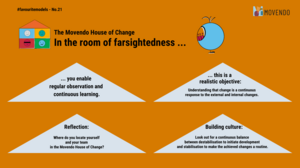#favouritemodel No.21 - House of Change - Farsightedness

This room is not included in the sequence of the classic emotional journey through the house of change, but is accessible from every other room and thus from every emotion.
The idea and experience behind this is that foresight and consideration can serve as a success factor in the processing of change emotions. That is why it is important for us to position the relevance transparently. As if from a helicopter perspective, the room of farsightedness serves to consciously look at the change, one's own emotions and the emotions of others from a new perspective at each point in time.
In the room of farsightedness, the following questions arise:
- What have we learned so far about our emotion processing strategy? Which experiences help us? What works particularly well? Which experiences and stories are particularly connectable? What tends not to help? Thus, this is where we can learn from looking back at previous change experiences. Successful interventions per phase can be repeated and thus specifically increase effectiveness. At the same time, it is important to remember that the experience of change is not linear and that past experiences cannot necessarily be transferred to the future.
- What is coming up next for us? Which next phases, emotions and needs do we already need to prepare for in order to continue leading effectively in our transformation? The space of farsightedness is particularly suitable for keeping a regular lookout during the course of a change process in order to plan and prepare well for the next steps, events and interventions. Especially the high emotionality of change requires to provide the room of farsightedness as a fixed part of the emotional journey in order to decide the next step well with some distance.
- What else do we need? Given the high emotionality, not all well-planned interventions are effective and that is why the room of farsightedness can also be visited spontaneously to prevent emerging patterns of intervention. In living and social systems, the principle is that if your strategy doesn't work, do something different. Accordingly, the room of farsightedness is equipped with exactly this question: What can we do differently in order to be successful?
If change is a constant in our lives, then the room of farsightedness also helps us to look ahead to the next changes and to continuously keep an eye out for the issues, innovations and changes that are on the horizon.
How does this #favouritemodel help you?
The room of farsightedness can be the place of refuge where emotions boil down a bit, opening at the same time the space to prepare for the next interventions. Here we:
- Reflect on what we have learned so far about our own change competencies - what helps us, what tends not to help us?
- Observe what challenges need to be addressed next.
- Select which interventions to try next to assist with emotion processing
- Evaluate what patterns are evident to interrupt dysfunctional patterns of intervention and processing and strengthen functional patterns
That is why the visit to the room of farsightedness must not only be regularly scheduled, but also carried out - physically, it is recommended to use a fixed meeting room for exactly this change of perspective in order to also experience an exterior change.











